International Marketing Management: AstraZeneca Australia Case Study
VerifiedAdded on 2020/02/24
|26
|6339
|42
Report
AI Summary
This report provides a comprehensive analysis of AstraZeneca's international marketing strategy, focusing on its potential expansion into the Australian market. The report begins with a market evaluation, highlighting the opportunities within Australia's healthcare and pharmaceutical sectors, and assessing the political risks involved, including expropriation, foreign exchange restrictions, and changes in laws. It then delves into AstraZeneca's sustainability goals, emphasizing its commitment to environmental protection, resource efficiency, and climate change mitigation strategies. The report also examines sales force management, outlining the key steps for effective hiring and management. Finally, it explores the cultural dimensions impacting the company's operations, comparing Australia and Malaysia based on Hofstede's cultural dimensions, including power distance, individualism, masculinity, uncertainty avoidance, long-term orientation, and indulgence. The report concludes with an overview of the key findings and recommendations for AstraZeneca's successful market entry and sustainable operations in Australia.
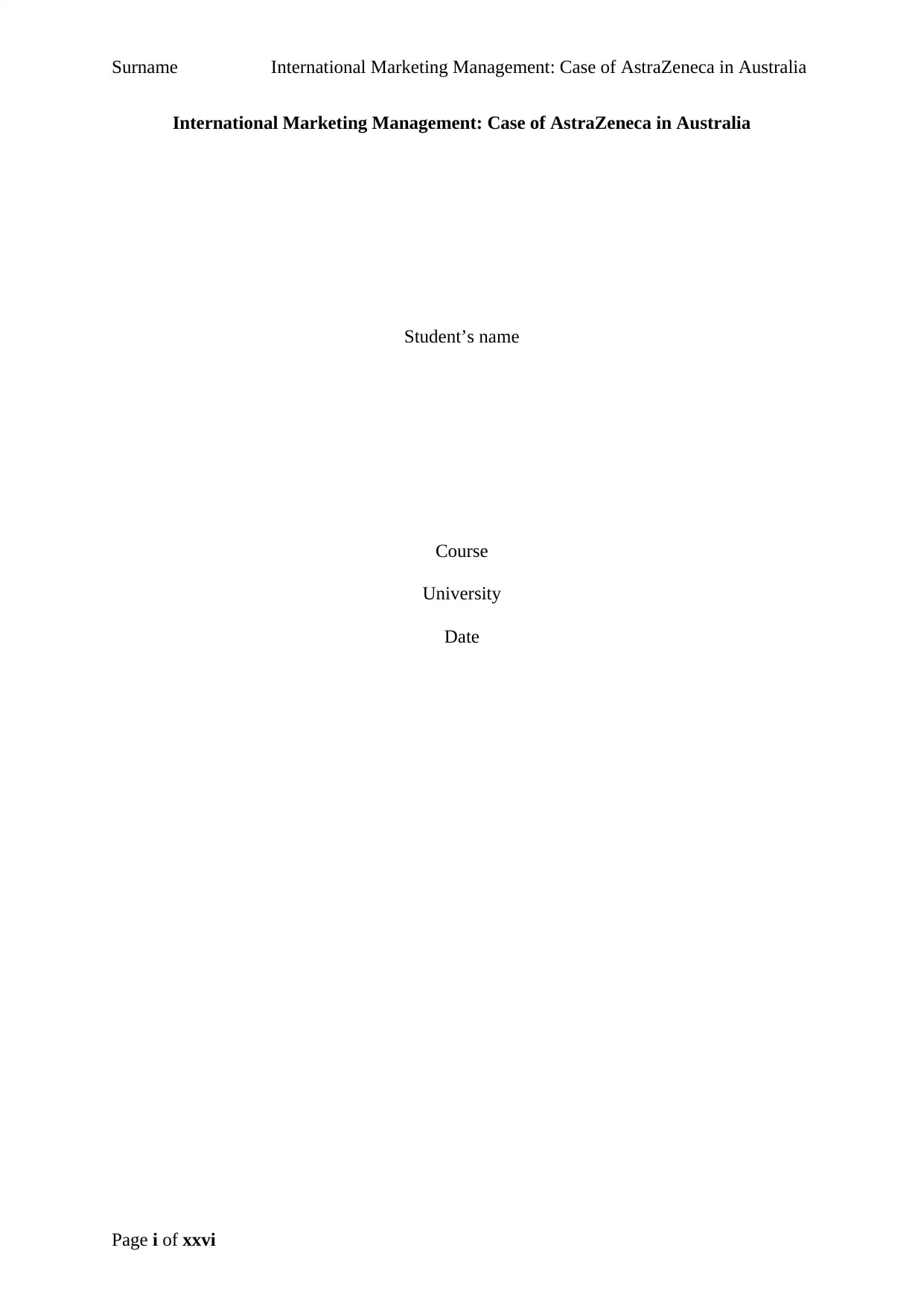
Surname International Marketing Management: Case of AstraZeneca in Australia
International Marketing Management: Case of AstraZeneca in Australia
Student’s name
Course
University
Date
Page i of xxvi
International Marketing Management: Case of AstraZeneca in Australia
Student’s name
Course
University
Date
Page i of xxvi
Paraphrase This Document
Need a fresh take? Get an instant paraphrase of this document with our AI Paraphraser
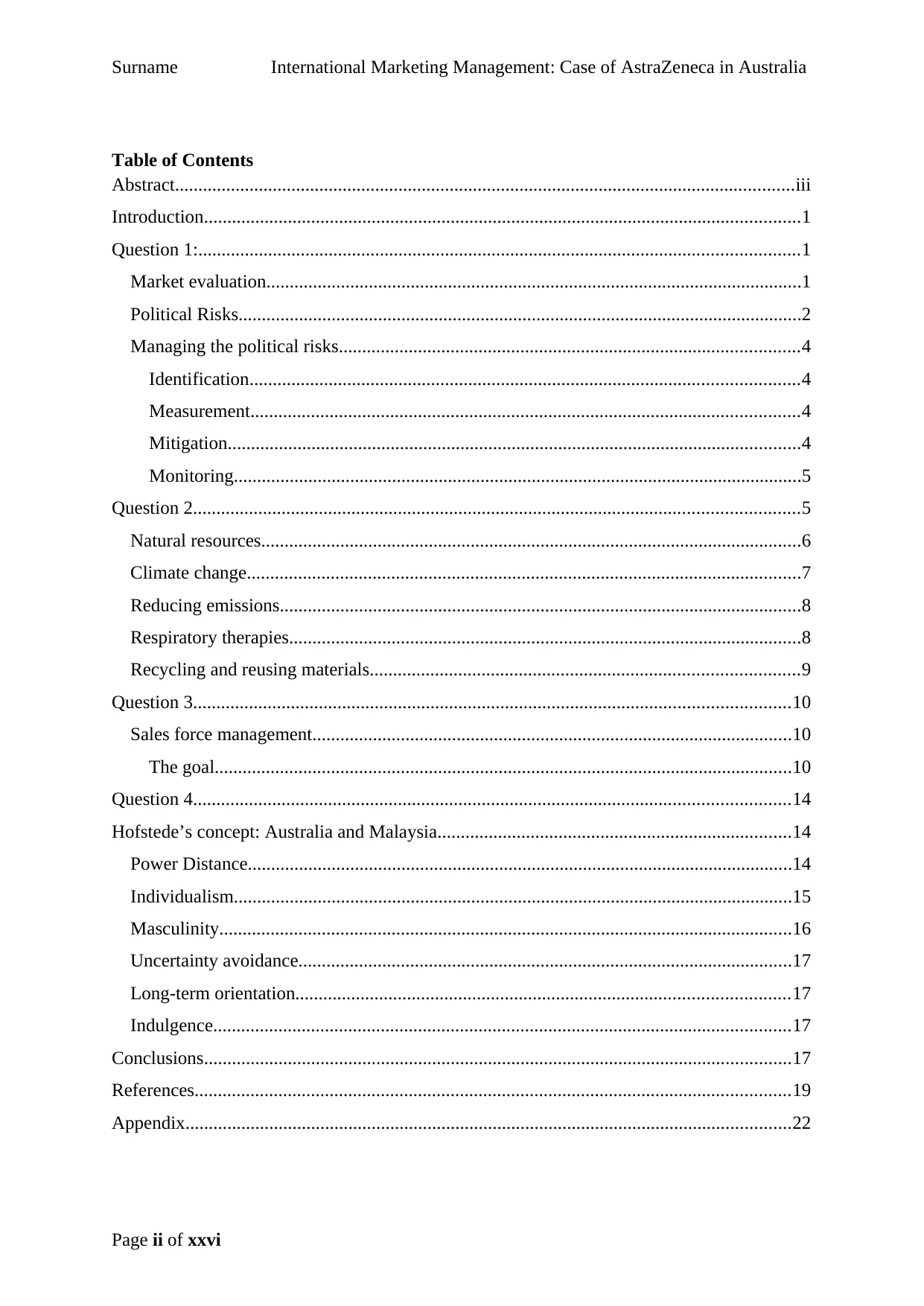
Surname International Marketing Management: Case of AstraZeneca in Australia
Table of Contents
Abstract.....................................................................................................................................iii
Introduction................................................................................................................................1
Question 1:.................................................................................................................................1
Market evaluation...................................................................................................................1
Political Risks.........................................................................................................................2
Managing the political risks...................................................................................................4
Identification......................................................................................................................4
Measurement......................................................................................................................4
Mitigation...........................................................................................................................4
Monitoring..........................................................................................................................5
Question 2..................................................................................................................................5
Natural resources....................................................................................................................6
Climate change.......................................................................................................................7
Reducing emissions................................................................................................................8
Respiratory therapies..............................................................................................................8
Recycling and reusing materials............................................................................................9
Question 3................................................................................................................................10
Sales force management.......................................................................................................10
The goal............................................................................................................................10
Question 4................................................................................................................................14
Hofstede’s concept: Australia and Malaysia............................................................................14
Power Distance.....................................................................................................................14
Individualism........................................................................................................................15
Masculinity...........................................................................................................................16
Uncertainty avoidance..........................................................................................................17
Long-term orientation..........................................................................................................17
Indulgence............................................................................................................................17
Conclusions..............................................................................................................................17
References................................................................................................................................19
Appendix..................................................................................................................................22
Page ii of xxvi
Table of Contents
Abstract.....................................................................................................................................iii
Introduction................................................................................................................................1
Question 1:.................................................................................................................................1
Market evaluation...................................................................................................................1
Political Risks.........................................................................................................................2
Managing the political risks...................................................................................................4
Identification......................................................................................................................4
Measurement......................................................................................................................4
Mitigation...........................................................................................................................4
Monitoring..........................................................................................................................5
Question 2..................................................................................................................................5
Natural resources....................................................................................................................6
Climate change.......................................................................................................................7
Reducing emissions................................................................................................................8
Respiratory therapies..............................................................................................................8
Recycling and reusing materials............................................................................................9
Question 3................................................................................................................................10
Sales force management.......................................................................................................10
The goal............................................................................................................................10
Question 4................................................................................................................................14
Hofstede’s concept: Australia and Malaysia............................................................................14
Power Distance.....................................................................................................................14
Individualism........................................................................................................................15
Masculinity...........................................................................................................................16
Uncertainty avoidance..........................................................................................................17
Long-term orientation..........................................................................................................17
Indulgence............................................................................................................................17
Conclusions..............................................................................................................................17
References................................................................................................................................19
Appendix..................................................................................................................................22
Page ii of xxvi
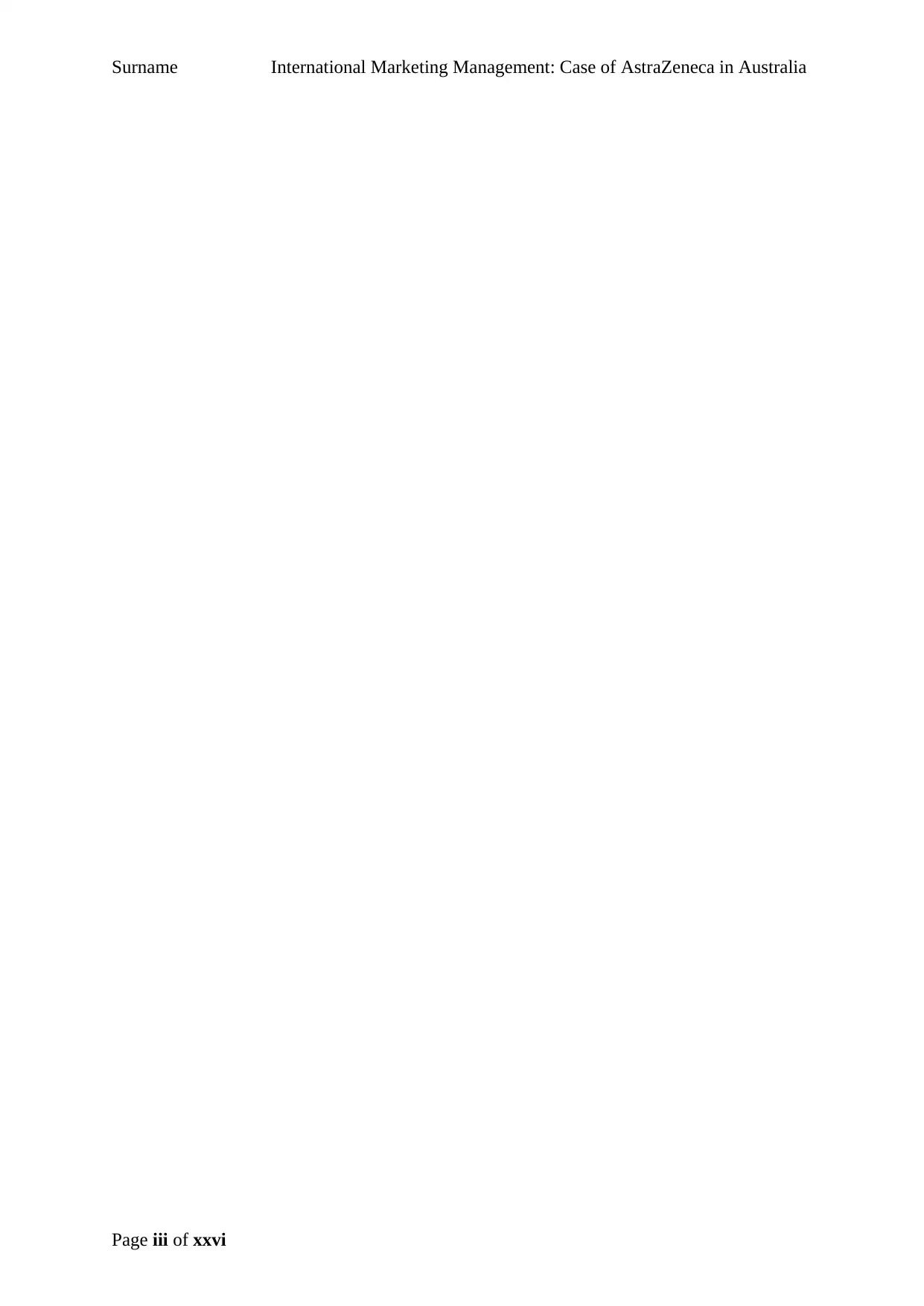
Surname International Marketing Management: Case of AstraZeneca in Australia
Page iii of xxvi
Page iii of xxvi
⊘ This is a preview!⊘
Do you want full access?
Subscribe today to unlock all pages.

Trusted by 1+ million students worldwide
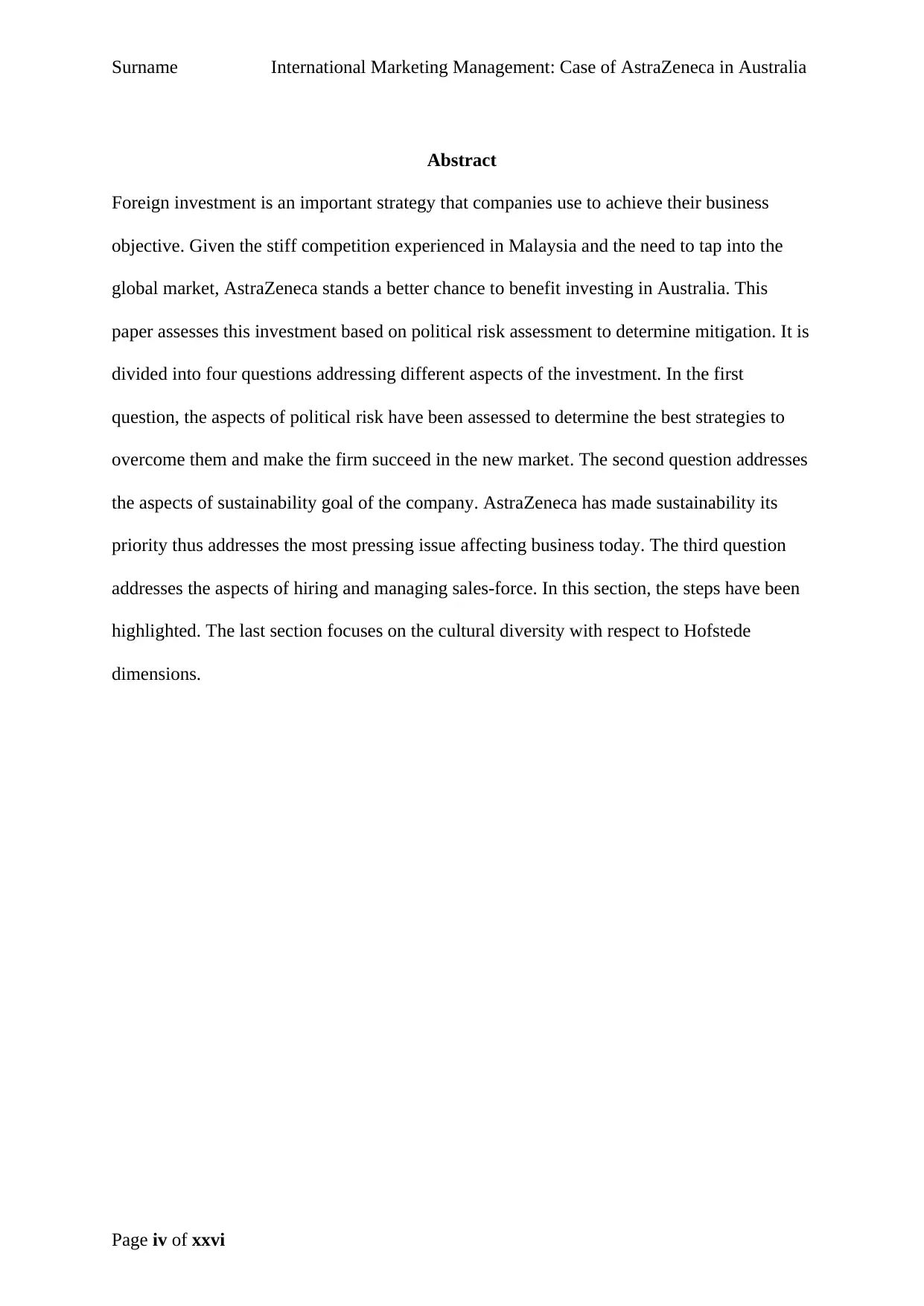
Surname International Marketing Management: Case of AstraZeneca in Australia
Abstract
Foreign investment is an important strategy that companies use to achieve their business
objective. Given the stiff competition experienced in Malaysia and the need to tap into the
global market, AstraZeneca stands a better chance to benefit investing in Australia. This
paper assesses this investment based on political risk assessment to determine mitigation. It is
divided into four questions addressing different aspects of the investment. In the first
question, the aspects of political risk have been assessed to determine the best strategies to
overcome them and make the firm succeed in the new market. The second question addresses
the aspects of sustainability goal of the company. AstraZeneca has made sustainability its
priority thus addresses the most pressing issue affecting business today. The third question
addresses the aspects of hiring and managing sales-force. In this section, the steps have been
highlighted. The last section focuses on the cultural diversity with respect to Hofstede
dimensions.
Page iv of xxvi
Abstract
Foreign investment is an important strategy that companies use to achieve their business
objective. Given the stiff competition experienced in Malaysia and the need to tap into the
global market, AstraZeneca stands a better chance to benefit investing in Australia. This
paper assesses this investment based on political risk assessment to determine mitigation. It is
divided into four questions addressing different aspects of the investment. In the first
question, the aspects of political risk have been assessed to determine the best strategies to
overcome them and make the firm succeed in the new market. The second question addresses
the aspects of sustainability goal of the company. AstraZeneca has made sustainability its
priority thus addresses the most pressing issue affecting business today. The third question
addresses the aspects of hiring and managing sales-force. In this section, the steps have been
highlighted. The last section focuses on the cultural diversity with respect to Hofstede
dimensions.
Page iv of xxvi
Paraphrase This Document
Need a fresh take? Get an instant paraphrase of this document with our AI Paraphraser
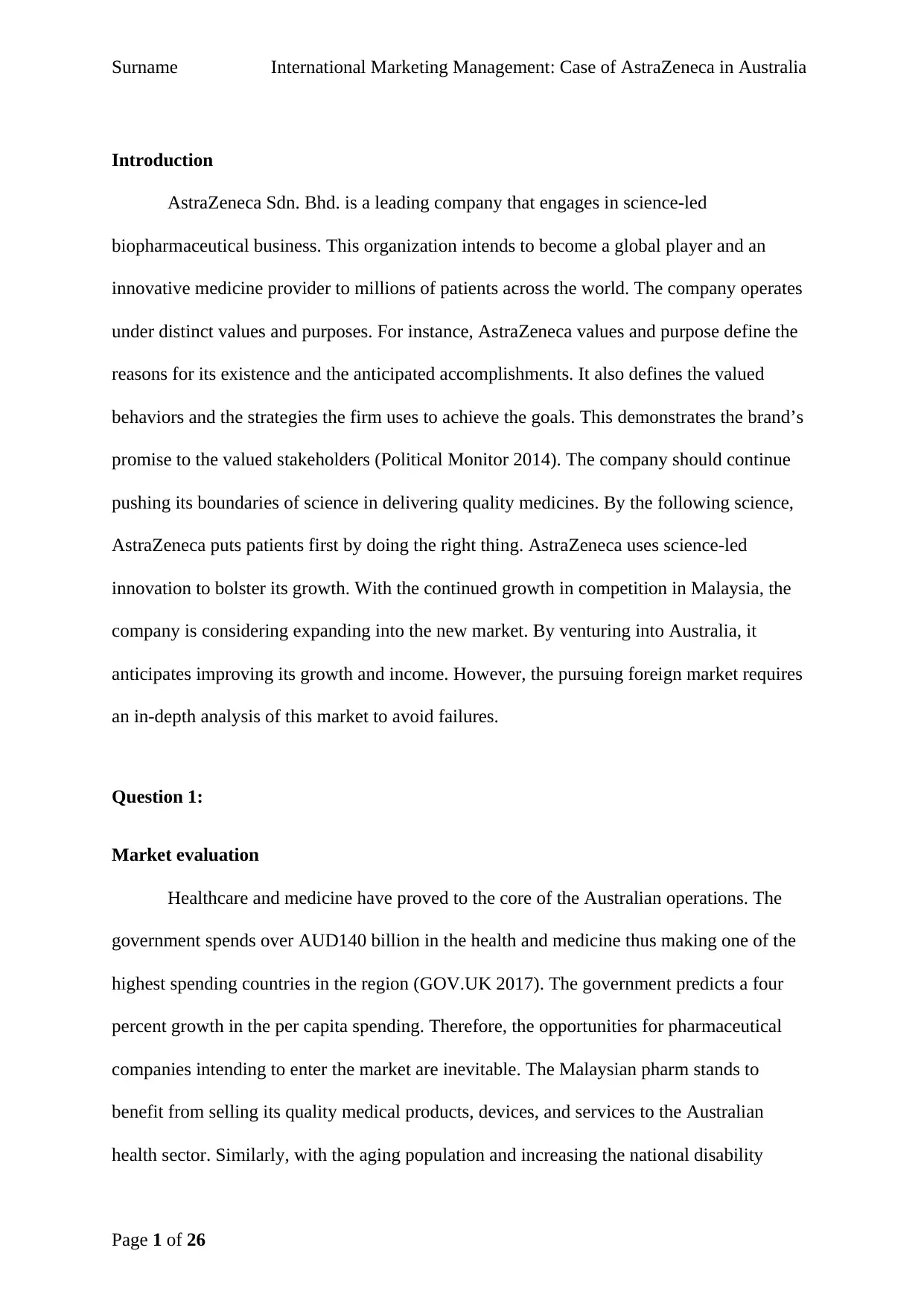
Surname International Marketing Management: Case of AstraZeneca in Australia
Introduction
AstraZeneca Sdn. Bhd. is a leading company that engages in science-led
biopharmaceutical business. This organization intends to become a global player and an
innovative medicine provider to millions of patients across the world. The company operates
under distinct values and purposes. For instance, AstraZeneca values and purpose define the
reasons for its existence and the anticipated accomplishments. It also defines the valued
behaviors and the strategies the firm uses to achieve the goals. This demonstrates the brand’s
promise to the valued stakeholders (Political Monitor 2014). The company should continue
pushing its boundaries of science in delivering quality medicines. By the following science,
AstraZeneca puts patients first by doing the right thing. AstraZeneca uses science-led
innovation to bolster its growth. With the continued growth in competition in Malaysia, the
company is considering expanding into the new market. By venturing into Australia, it
anticipates improving its growth and income. However, the pursuing foreign market requires
an in-depth analysis of this market to avoid failures.
Question 1:
Market evaluation
Healthcare and medicine have proved to the core of the Australian operations. The
government spends over AUD140 billion in the health and medicine thus making one of the
highest spending countries in the region (GOV.UK 2017). The government predicts a four
percent growth in the per capita spending. Therefore, the opportunities for pharmaceutical
companies intending to enter the market are inevitable. The Malaysian pharm stands to
benefit from selling its quality medical products, devices, and services to the Australian
health sector. Similarly, with the aging population and increasing the national disability
Page 1 of 26
Introduction
AstraZeneca Sdn. Bhd. is a leading company that engages in science-led
biopharmaceutical business. This organization intends to become a global player and an
innovative medicine provider to millions of patients across the world. The company operates
under distinct values and purposes. For instance, AstraZeneca values and purpose define the
reasons for its existence and the anticipated accomplishments. It also defines the valued
behaviors and the strategies the firm uses to achieve the goals. This demonstrates the brand’s
promise to the valued stakeholders (Political Monitor 2014). The company should continue
pushing its boundaries of science in delivering quality medicines. By the following science,
AstraZeneca puts patients first by doing the right thing. AstraZeneca uses science-led
innovation to bolster its growth. With the continued growth in competition in Malaysia, the
company is considering expanding into the new market. By venturing into Australia, it
anticipates improving its growth and income. However, the pursuing foreign market requires
an in-depth analysis of this market to avoid failures.
Question 1:
Market evaluation
Healthcare and medicine have proved to the core of the Australian operations. The
government spends over AUD140 billion in the health and medicine thus making one of the
highest spending countries in the region (GOV.UK 2017). The government predicts a four
percent growth in the per capita spending. Therefore, the opportunities for pharmaceutical
companies intending to enter the market are inevitable. The Malaysian pharm stands to
benefit from selling its quality medical products, devices, and services to the Australian
health sector. Similarly, with the aging population and increasing the national disability
Page 1 of 26
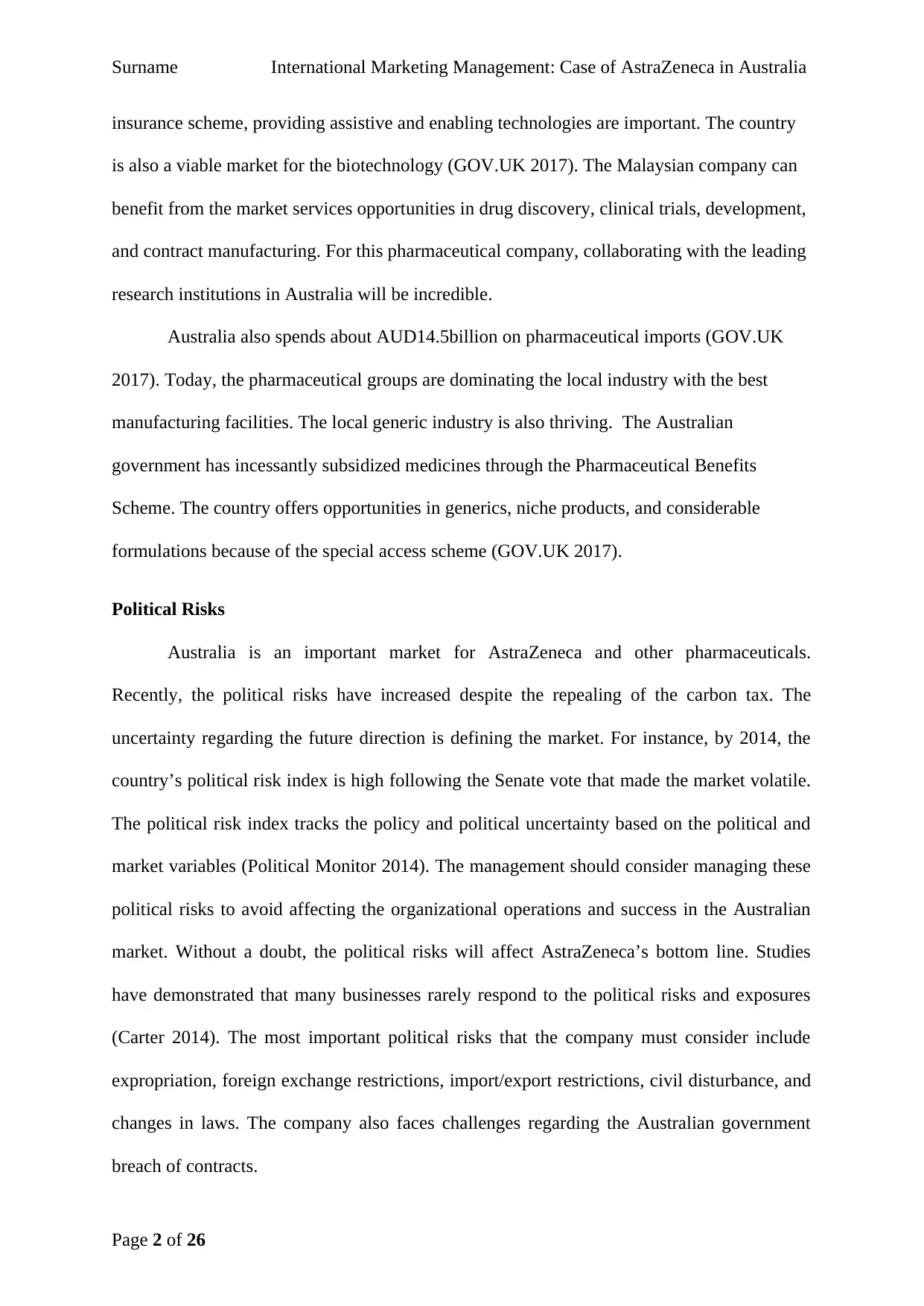
Surname International Marketing Management: Case of AstraZeneca in Australia
insurance scheme, providing assistive and enabling technologies are important. The country
is also a viable market for the biotechnology (GOV.UK 2017). The Malaysian company can
benefit from the market services opportunities in drug discovery, clinical trials, development,
and contract manufacturing. For this pharmaceutical company, collaborating with the leading
research institutions in Australia will be incredible.
Australia also spends about AUD14.5billion on pharmaceutical imports (GOV.UK
2017). Today, the pharmaceutical groups are dominating the local industry with the best
manufacturing facilities. The local generic industry is also thriving. The Australian
government has incessantly subsidized medicines through the Pharmaceutical Benefits
Scheme. The country offers opportunities in generics, niche products, and considerable
formulations because of the special access scheme (GOV.UK 2017).
Political Risks
Australia is an important market for AstraZeneca and other pharmaceuticals.
Recently, the political risks have increased despite the repealing of the carbon tax. The
uncertainty regarding the future direction is defining the market. For instance, by 2014, the
country’s political risk index is high following the Senate vote that made the market volatile.
The political risk index tracks the policy and political uncertainty based on the political and
market variables (Political Monitor 2014). The management should consider managing these
political risks to avoid affecting the organizational operations and success in the Australian
market. Without a doubt, the political risks will affect AstraZeneca’s bottom line. Studies
have demonstrated that many businesses rarely respond to the political risks and exposures
(Carter 2014). The most important political risks that the company must consider include
expropriation, foreign exchange restrictions, import/export restrictions, civil disturbance, and
changes in laws. The company also faces challenges regarding the Australian government
breach of contracts.
Page 2 of 26
insurance scheme, providing assistive and enabling technologies are important. The country
is also a viable market for the biotechnology (GOV.UK 2017). The Malaysian company can
benefit from the market services opportunities in drug discovery, clinical trials, development,
and contract manufacturing. For this pharmaceutical company, collaborating with the leading
research institutions in Australia will be incredible.
Australia also spends about AUD14.5billion on pharmaceutical imports (GOV.UK
2017). Today, the pharmaceutical groups are dominating the local industry with the best
manufacturing facilities. The local generic industry is also thriving. The Australian
government has incessantly subsidized medicines through the Pharmaceutical Benefits
Scheme. The country offers opportunities in generics, niche products, and considerable
formulations because of the special access scheme (GOV.UK 2017).
Political Risks
Australia is an important market for AstraZeneca and other pharmaceuticals.
Recently, the political risks have increased despite the repealing of the carbon tax. The
uncertainty regarding the future direction is defining the market. For instance, by 2014, the
country’s political risk index is high following the Senate vote that made the market volatile.
The political risk index tracks the policy and political uncertainty based on the political and
market variables (Political Monitor 2014). The management should consider managing these
political risks to avoid affecting the organizational operations and success in the Australian
market. Without a doubt, the political risks will affect AstraZeneca’s bottom line. Studies
have demonstrated that many businesses rarely respond to the political risks and exposures
(Carter 2014). The most important political risks that the company must consider include
expropriation, foreign exchange restrictions, import/export restrictions, civil disturbance, and
changes in laws. The company also faces challenges regarding the Australian government
breach of contracts.
Page 2 of 26
⊘ This is a preview!⊘
Do you want full access?
Subscribe today to unlock all pages.

Trusted by 1+ million students worldwide
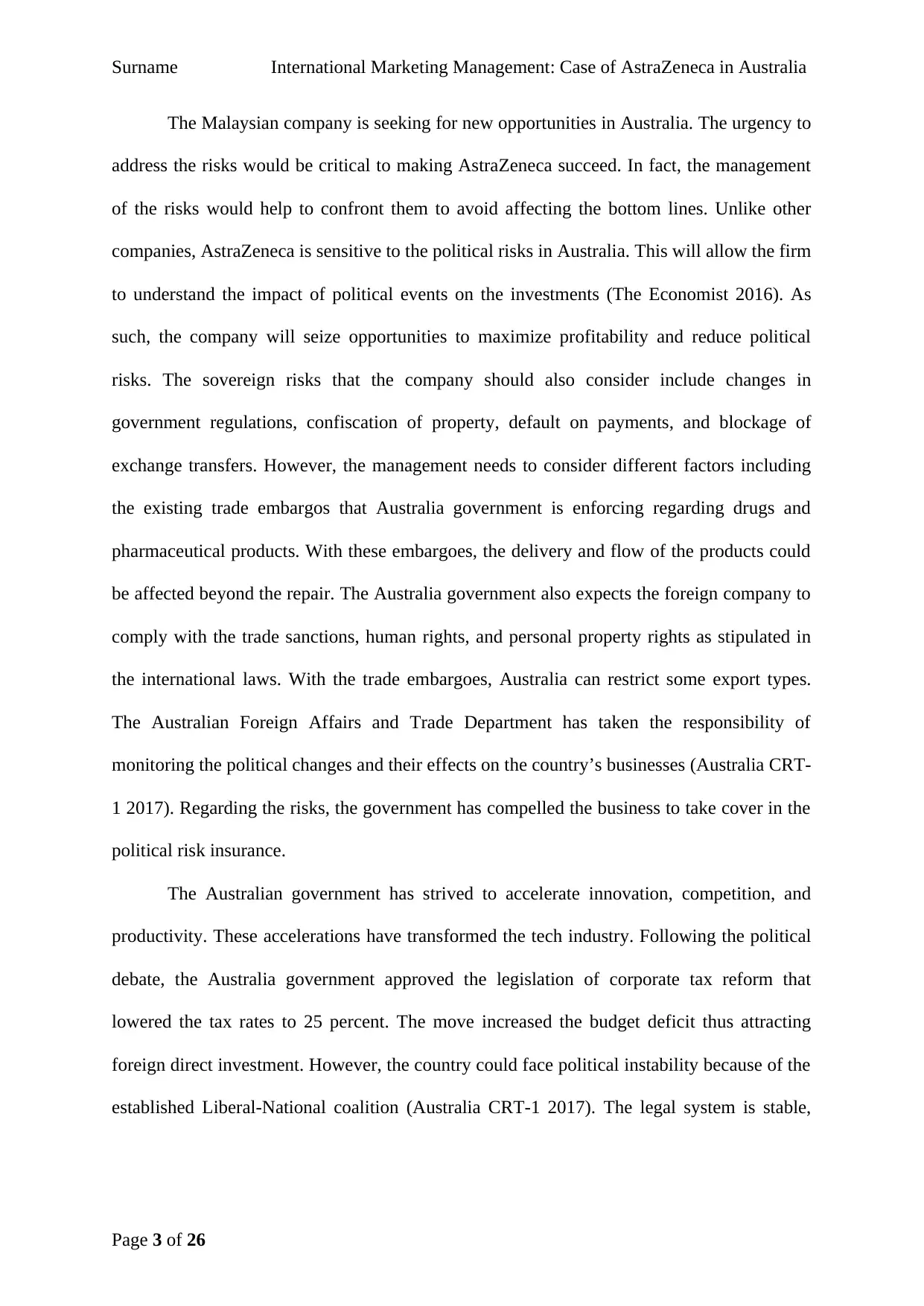
Surname International Marketing Management: Case of AstraZeneca in Australia
The Malaysian company is seeking for new opportunities in Australia. The urgency to
address the risks would be critical to making AstraZeneca succeed. In fact, the management
of the risks would help to confront them to avoid affecting the bottom lines. Unlike other
companies, AstraZeneca is sensitive to the political risks in Australia. This will allow the firm
to understand the impact of political events on the investments (The Economist 2016). As
such, the company will seize opportunities to maximize profitability and reduce political
risks. The sovereign risks that the company should also consider include changes in
government regulations, confiscation of property, default on payments, and blockage of
exchange transfers. However, the management needs to consider different factors including
the existing trade embargos that Australia government is enforcing regarding drugs and
pharmaceutical products. With these embargoes, the delivery and flow of the products could
be affected beyond the repair. The Australia government also expects the foreign company to
comply with the trade sanctions, human rights, and personal property rights as stipulated in
the international laws. With the trade embargoes, Australia can restrict some export types.
The Australian Foreign Affairs and Trade Department has taken the responsibility of
monitoring the political changes and their effects on the country’s businesses (Australia CRT-
1 2017). Regarding the risks, the government has compelled the business to take cover in the
political risk insurance.
The Australian government has strived to accelerate innovation, competition, and
productivity. These accelerations have transformed the tech industry. Following the political
debate, the Australia government approved the legislation of corporate tax reform that
lowered the tax rates to 25 percent. The move increased the budget deficit thus attracting
foreign direct investment. However, the country could face political instability because of the
established Liberal-National coalition (Australia CRT-1 2017). The legal system is stable,
Page 3 of 26
The Malaysian company is seeking for new opportunities in Australia. The urgency to
address the risks would be critical to making AstraZeneca succeed. In fact, the management
of the risks would help to confront them to avoid affecting the bottom lines. Unlike other
companies, AstraZeneca is sensitive to the political risks in Australia. This will allow the firm
to understand the impact of political events on the investments (The Economist 2016). As
such, the company will seize opportunities to maximize profitability and reduce political
risks. The sovereign risks that the company should also consider include changes in
government regulations, confiscation of property, default on payments, and blockage of
exchange transfers. However, the management needs to consider different factors including
the existing trade embargos that Australia government is enforcing regarding drugs and
pharmaceutical products. With these embargoes, the delivery and flow of the products could
be affected beyond the repair. The Australia government also expects the foreign company to
comply with the trade sanctions, human rights, and personal property rights as stipulated in
the international laws. With the trade embargoes, Australia can restrict some export types.
The Australian Foreign Affairs and Trade Department has taken the responsibility of
monitoring the political changes and their effects on the country’s businesses (Australia CRT-
1 2017). Regarding the risks, the government has compelled the business to take cover in the
political risk insurance.
The Australian government has strived to accelerate innovation, competition, and
productivity. These accelerations have transformed the tech industry. Following the political
debate, the Australia government approved the legislation of corporate tax reform that
lowered the tax rates to 25 percent. The move increased the budget deficit thus attracting
foreign direct investment. However, the country could face political instability because of the
established Liberal-National coalition (Australia CRT-1 2017). The legal system is stable,
Page 3 of 26
Paraphrase This Document
Need a fresh take? Get an instant paraphrase of this document with our AI Paraphraser
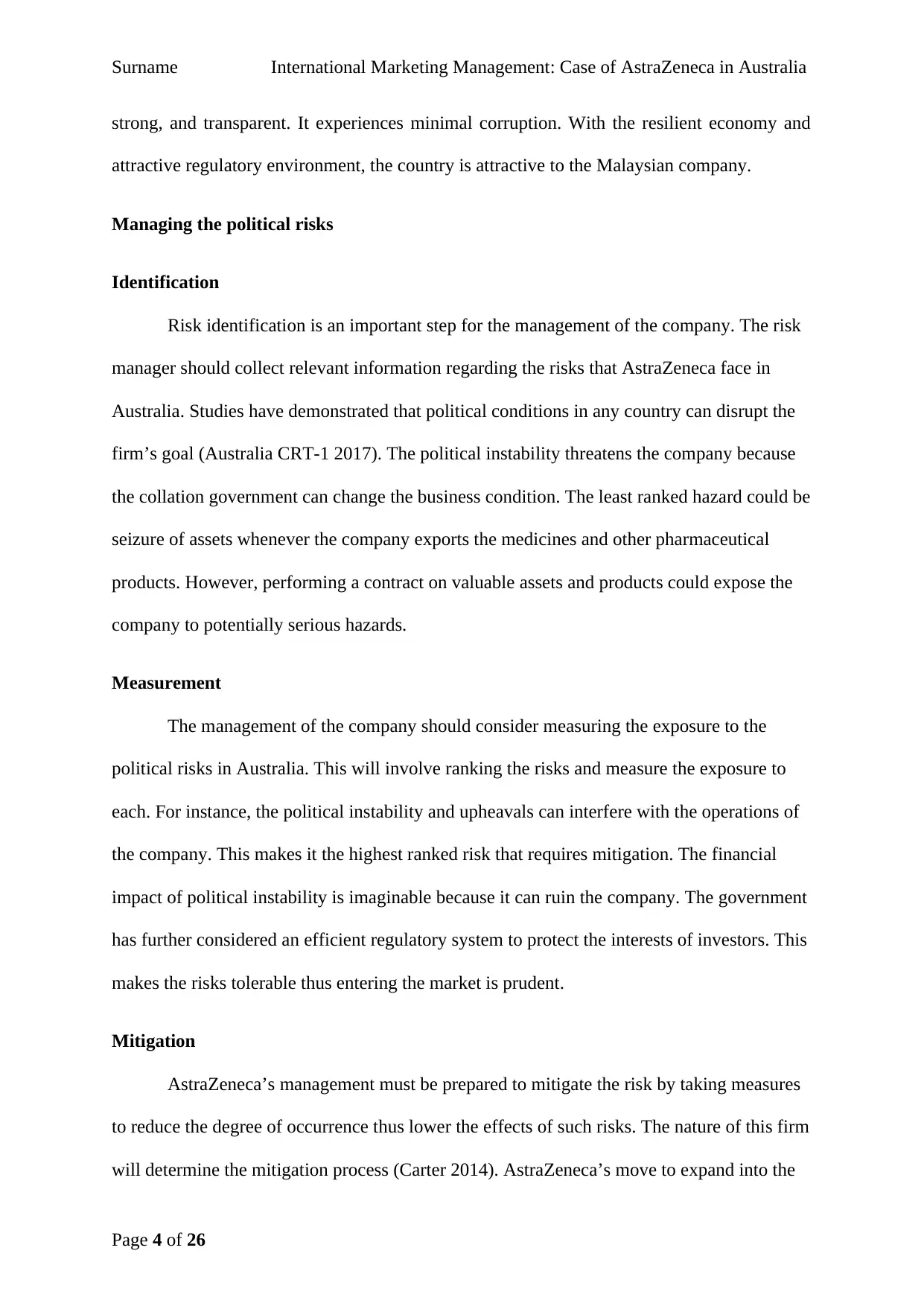
Surname International Marketing Management: Case of AstraZeneca in Australia
strong, and transparent. It experiences minimal corruption. With the resilient economy and
attractive regulatory environment, the country is attractive to the Malaysian company.
Managing the political risks
Identification
Risk identification is an important step for the management of the company. The risk
manager should collect relevant information regarding the risks that AstraZeneca face in
Australia. Studies have demonstrated that political conditions in any country can disrupt the
firm’s goal (Australia CRT-1 2017). The political instability threatens the company because
the collation government can change the business condition. The least ranked hazard could be
seizure of assets whenever the company exports the medicines and other pharmaceutical
products. However, performing a contract on valuable assets and products could expose the
company to potentially serious hazards.
Measurement
The management of the company should consider measuring the exposure to the
political risks in Australia. This will involve ranking the risks and measure the exposure to
each. For instance, the political instability and upheavals can interfere with the operations of
the company. This makes it the highest ranked risk that requires mitigation. The financial
impact of political instability is imaginable because it can ruin the company. The government
has further considered an efficient regulatory system to protect the interests of investors. This
makes the risks tolerable thus entering the market is prudent.
Mitigation
AstraZeneca’s management must be prepared to mitigate the risk by taking measures
to reduce the degree of occurrence thus lower the effects of such risks. The nature of this firm
will determine the mitigation process (Carter 2014). AstraZeneca’s move to expand into the
Page 4 of 26
strong, and transparent. It experiences minimal corruption. With the resilient economy and
attractive regulatory environment, the country is attractive to the Malaysian company.
Managing the political risks
Identification
Risk identification is an important step for the management of the company. The risk
manager should collect relevant information regarding the risks that AstraZeneca face in
Australia. Studies have demonstrated that political conditions in any country can disrupt the
firm’s goal (Australia CRT-1 2017). The political instability threatens the company because
the collation government can change the business condition. The least ranked hazard could be
seizure of assets whenever the company exports the medicines and other pharmaceutical
products. However, performing a contract on valuable assets and products could expose the
company to potentially serious hazards.
Measurement
The management of the company should consider measuring the exposure to the
political risks in Australia. This will involve ranking the risks and measure the exposure to
each. For instance, the political instability and upheavals can interfere with the operations of
the company. This makes it the highest ranked risk that requires mitigation. The financial
impact of political instability is imaginable because it can ruin the company. The government
has further considered an efficient regulatory system to protect the interests of investors. This
makes the risks tolerable thus entering the market is prudent.
Mitigation
AstraZeneca’s management must be prepared to mitigate the risk by taking measures
to reduce the degree of occurrence thus lower the effects of such risks. The nature of this firm
will determine the mitigation process (Carter 2014). AstraZeneca’s move to expand into the
Page 4 of 26
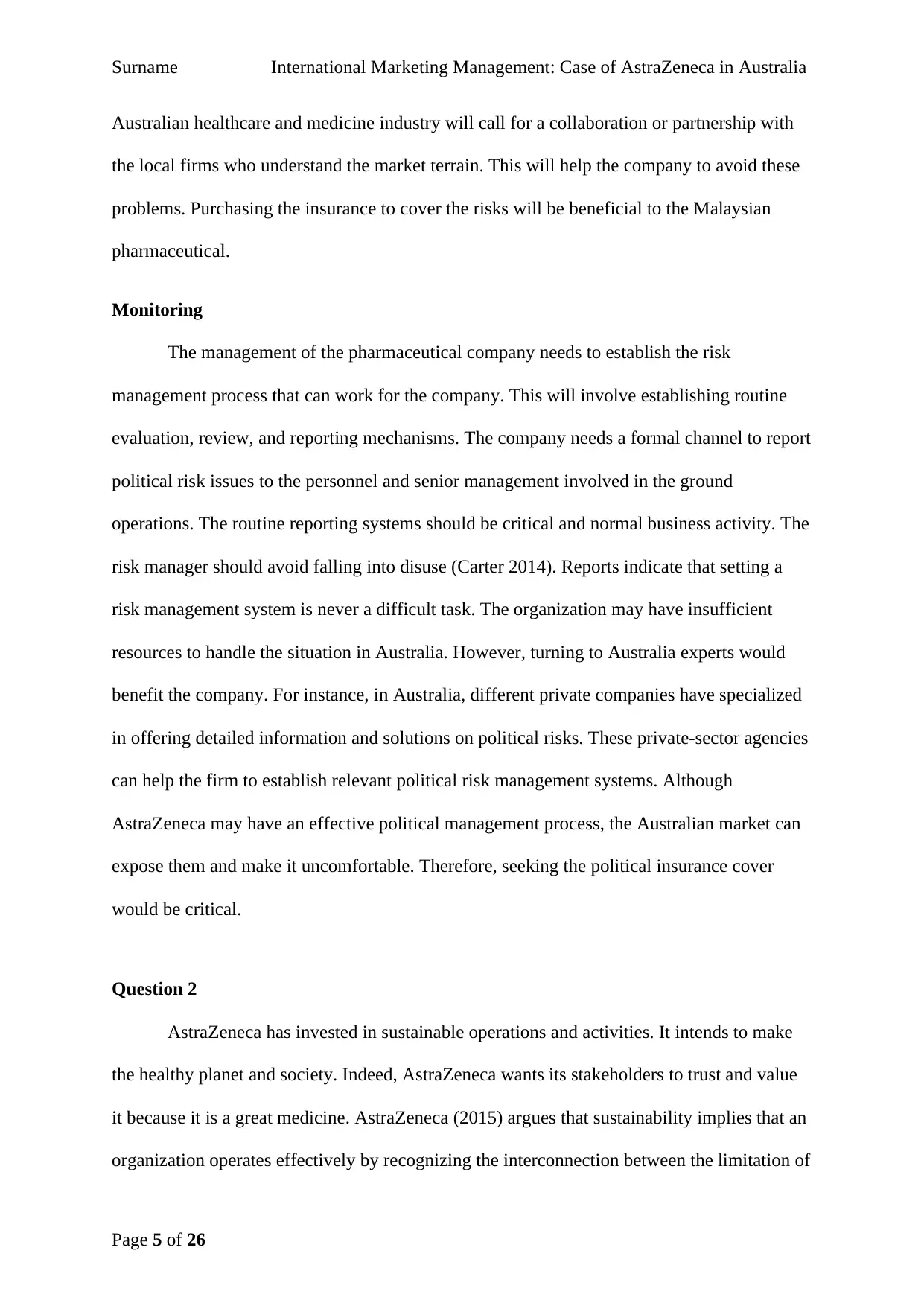
Surname International Marketing Management: Case of AstraZeneca in Australia
Australian healthcare and medicine industry will call for a collaboration or partnership with
the local firms who understand the market terrain. This will help the company to avoid these
problems. Purchasing the insurance to cover the risks will be beneficial to the Malaysian
pharmaceutical.
Monitoring
The management of the pharmaceutical company needs to establish the risk
management process that can work for the company. This will involve establishing routine
evaluation, review, and reporting mechanisms. The company needs a formal channel to report
political risk issues to the personnel and senior management involved in the ground
operations. The routine reporting systems should be critical and normal business activity. The
risk manager should avoid falling into disuse (Carter 2014). Reports indicate that setting a
risk management system is never a difficult task. The organization may have insufficient
resources to handle the situation in Australia. However, turning to Australia experts would
benefit the company. For instance, in Australia, different private companies have specialized
in offering detailed information and solutions on political risks. These private-sector agencies
can help the firm to establish relevant political risk management systems. Although
AstraZeneca may have an effective political management process, the Australian market can
expose them and make it uncomfortable. Therefore, seeking the political insurance cover
would be critical.
Question 2
AstraZeneca has invested in sustainable operations and activities. It intends to make
the healthy planet and society. Indeed, AstraZeneca wants its stakeholders to trust and value
it because it is a great medicine. AstraZeneca (2015) argues that sustainability implies that an
organization operates effectively by recognizing the interconnection between the limitation of
Page 5 of 26
Australian healthcare and medicine industry will call for a collaboration or partnership with
the local firms who understand the market terrain. This will help the company to avoid these
problems. Purchasing the insurance to cover the risks will be beneficial to the Malaysian
pharmaceutical.
Monitoring
The management of the pharmaceutical company needs to establish the risk
management process that can work for the company. This will involve establishing routine
evaluation, review, and reporting mechanisms. The company needs a formal channel to report
political risk issues to the personnel and senior management involved in the ground
operations. The routine reporting systems should be critical and normal business activity. The
risk manager should avoid falling into disuse (Carter 2014). Reports indicate that setting a
risk management system is never a difficult task. The organization may have insufficient
resources to handle the situation in Australia. However, turning to Australia experts would
benefit the company. For instance, in Australia, different private companies have specialized
in offering detailed information and solutions on political risks. These private-sector agencies
can help the firm to establish relevant political risk management systems. Although
AstraZeneca may have an effective political management process, the Australian market can
expose them and make it uncomfortable. Therefore, seeking the political insurance cover
would be critical.
Question 2
AstraZeneca has invested in sustainable operations and activities. It intends to make
the healthy planet and society. Indeed, AstraZeneca wants its stakeholders to trust and value
it because it is a great medicine. AstraZeneca (2015) argues that sustainability implies that an
organization operates effectively by recognizing the interconnection between the limitation of
Page 5 of 26
⊘ This is a preview!⊘
Do you want full access?
Subscribe today to unlock all pages.

Trusted by 1+ million students worldwide
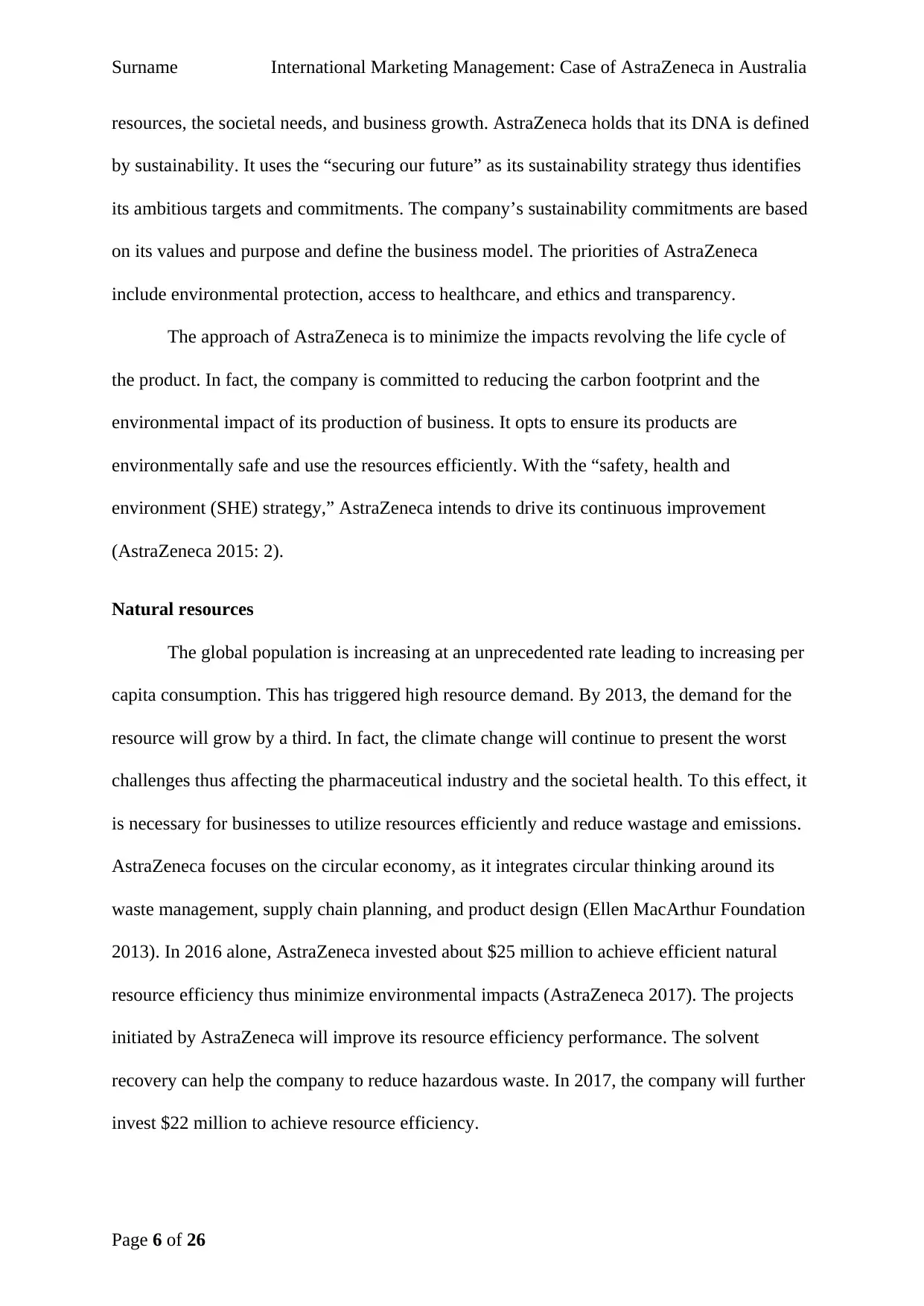
Surname International Marketing Management: Case of AstraZeneca in Australia
resources, the societal needs, and business growth. AstraZeneca holds that its DNA is defined
by sustainability. It uses the “securing our future” as its sustainability strategy thus identifies
its ambitious targets and commitments. The company’s sustainability commitments are based
on its values and purpose and define the business model. The priorities of AstraZeneca
include environmental protection, access to healthcare, and ethics and transparency.
The approach of AstraZeneca is to minimize the impacts revolving the life cycle of
the product. In fact, the company is committed to reducing the carbon footprint and the
environmental impact of its production of business. It opts to ensure its products are
environmentally safe and use the resources efficiently. With the “safety, health and
environment (SHE) strategy,” AstraZeneca intends to drive its continuous improvement
(AstraZeneca 2015: 2).
Natural resources
The global population is increasing at an unprecedented rate leading to increasing per
capita consumption. This has triggered high resource demand. By 2013, the demand for the
resource will grow by a third. In fact, the climate change will continue to present the worst
challenges thus affecting the pharmaceutical industry and the societal health. To this effect, it
is necessary for businesses to utilize resources efficiently and reduce wastage and emissions.
AstraZeneca focuses on the circular economy, as it integrates circular thinking around its
waste management, supply chain planning, and product design (Ellen MacArthur Foundation
2013). In 2016 alone, AstraZeneca invested about $25 million to achieve efficient natural
resource efficiency thus minimize environmental impacts (AstraZeneca 2017). The projects
initiated by AstraZeneca will improve its resource efficiency performance. The solvent
recovery can help the company to reduce hazardous waste. In 2017, the company will further
invest $22 million to achieve resource efficiency.
Page 6 of 26
resources, the societal needs, and business growth. AstraZeneca holds that its DNA is defined
by sustainability. It uses the “securing our future” as its sustainability strategy thus identifies
its ambitious targets and commitments. The company’s sustainability commitments are based
on its values and purpose and define the business model. The priorities of AstraZeneca
include environmental protection, access to healthcare, and ethics and transparency.
The approach of AstraZeneca is to minimize the impacts revolving the life cycle of
the product. In fact, the company is committed to reducing the carbon footprint and the
environmental impact of its production of business. It opts to ensure its products are
environmentally safe and use the resources efficiently. With the “safety, health and
environment (SHE) strategy,” AstraZeneca intends to drive its continuous improvement
(AstraZeneca 2015: 2).
Natural resources
The global population is increasing at an unprecedented rate leading to increasing per
capita consumption. This has triggered high resource demand. By 2013, the demand for the
resource will grow by a third. In fact, the climate change will continue to present the worst
challenges thus affecting the pharmaceutical industry and the societal health. To this effect, it
is necessary for businesses to utilize resources efficiently and reduce wastage and emissions.
AstraZeneca focuses on the circular economy, as it integrates circular thinking around its
waste management, supply chain planning, and product design (Ellen MacArthur Foundation
2013). In 2016 alone, AstraZeneca invested about $25 million to achieve efficient natural
resource efficiency thus minimize environmental impacts (AstraZeneca 2017). The projects
initiated by AstraZeneca will improve its resource efficiency performance. The solvent
recovery can help the company to reduce hazardous waste. In 2017, the company will further
invest $22 million to achieve resource efficiency.
Page 6 of 26
Paraphrase This Document
Need a fresh take? Get an instant paraphrase of this document with our AI Paraphraser
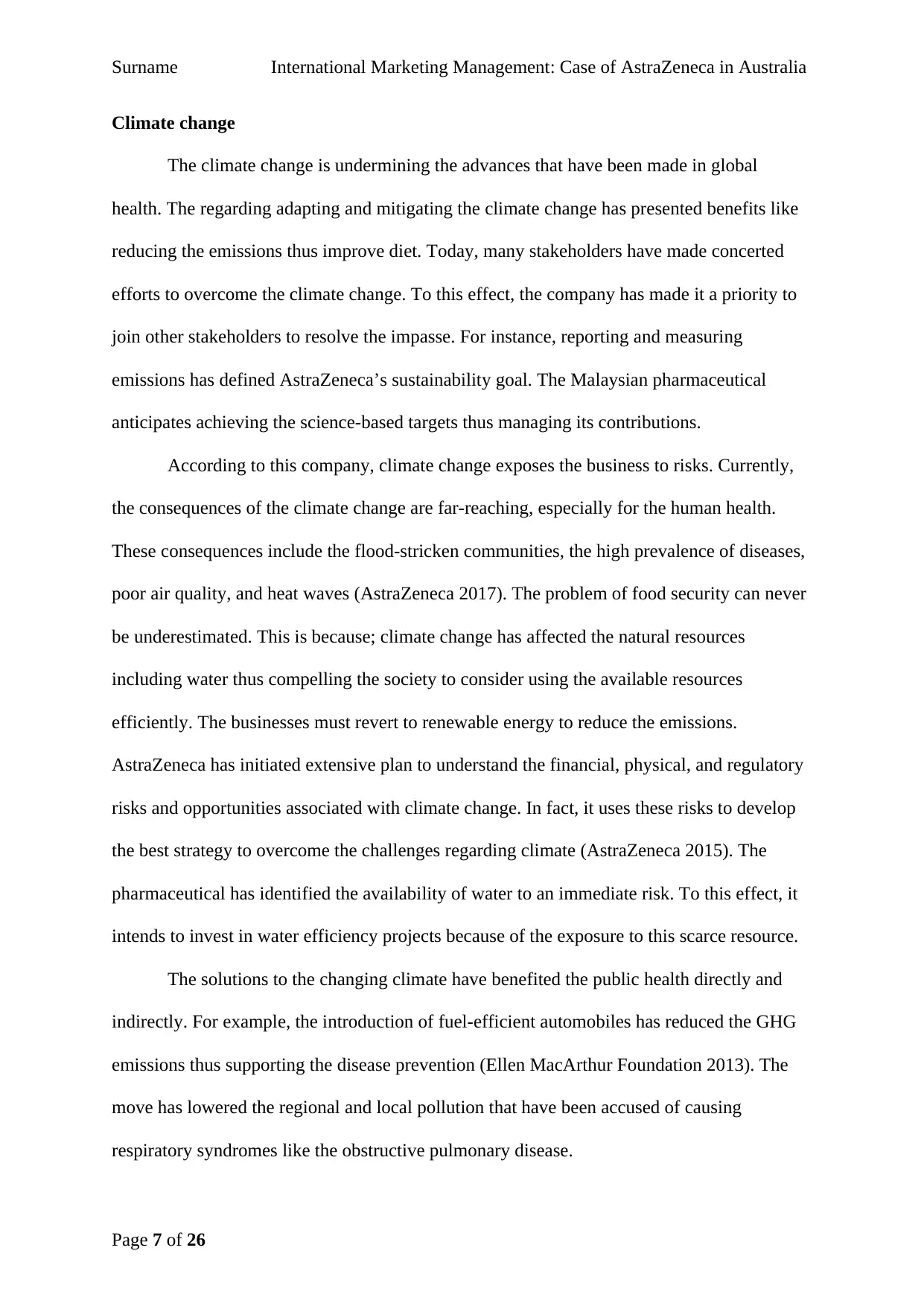
Surname International Marketing Management: Case of AstraZeneca in Australia
Climate change
The climate change is undermining the advances that have been made in global
health. The regarding adapting and mitigating the climate change has presented benefits like
reducing the emissions thus improve diet. Today, many stakeholders have made concerted
efforts to overcome the climate change. To this effect, the company has made it a priority to
join other stakeholders to resolve the impasse. For instance, reporting and measuring
emissions has defined AstraZeneca’s sustainability goal. The Malaysian pharmaceutical
anticipates achieving the science-based targets thus managing its contributions.
According to this company, climate change exposes the business to risks. Currently,
the consequences of the climate change are far-reaching, especially for the human health.
These consequences include the flood-stricken communities, the high prevalence of diseases,
poor air quality, and heat waves (AstraZeneca 2017). The problem of food security can never
be underestimated. This is because; climate change has affected the natural resources
including water thus compelling the society to consider using the available resources
efficiently. The businesses must revert to renewable energy to reduce the emissions.
AstraZeneca has initiated extensive plan to understand the financial, physical, and regulatory
risks and opportunities associated with climate change. In fact, it uses these risks to develop
the best strategy to overcome the challenges regarding climate (AstraZeneca 2015). The
pharmaceutical has identified the availability of water to an immediate risk. To this effect, it
intends to invest in water efficiency projects because of the exposure to this scarce resource.
The solutions to the changing climate have benefited the public health directly and
indirectly. For example, the introduction of fuel-efficient automobiles has reduced the GHG
emissions thus supporting the disease prevention (Ellen MacArthur Foundation 2013). The
move has lowered the regional and local pollution that have been accused of causing
respiratory syndromes like the obstructive pulmonary disease.
Page 7 of 26
Climate change
The climate change is undermining the advances that have been made in global
health. The regarding adapting and mitigating the climate change has presented benefits like
reducing the emissions thus improve diet. Today, many stakeholders have made concerted
efforts to overcome the climate change. To this effect, the company has made it a priority to
join other stakeholders to resolve the impasse. For instance, reporting and measuring
emissions has defined AstraZeneca’s sustainability goal. The Malaysian pharmaceutical
anticipates achieving the science-based targets thus managing its contributions.
According to this company, climate change exposes the business to risks. Currently,
the consequences of the climate change are far-reaching, especially for the human health.
These consequences include the flood-stricken communities, the high prevalence of diseases,
poor air quality, and heat waves (AstraZeneca 2017). The problem of food security can never
be underestimated. This is because; climate change has affected the natural resources
including water thus compelling the society to consider using the available resources
efficiently. The businesses must revert to renewable energy to reduce the emissions.
AstraZeneca has initiated extensive plan to understand the financial, physical, and regulatory
risks and opportunities associated with climate change. In fact, it uses these risks to develop
the best strategy to overcome the challenges regarding climate (AstraZeneca 2015). The
pharmaceutical has identified the availability of water to an immediate risk. To this effect, it
intends to invest in water efficiency projects because of the exposure to this scarce resource.
The solutions to the changing climate have benefited the public health directly and
indirectly. For example, the introduction of fuel-efficient automobiles has reduced the GHG
emissions thus supporting the disease prevention (Ellen MacArthur Foundation 2013). The
move has lowered the regional and local pollution that have been accused of causing
respiratory syndromes like the obstructive pulmonary disease.
Page 7 of 26
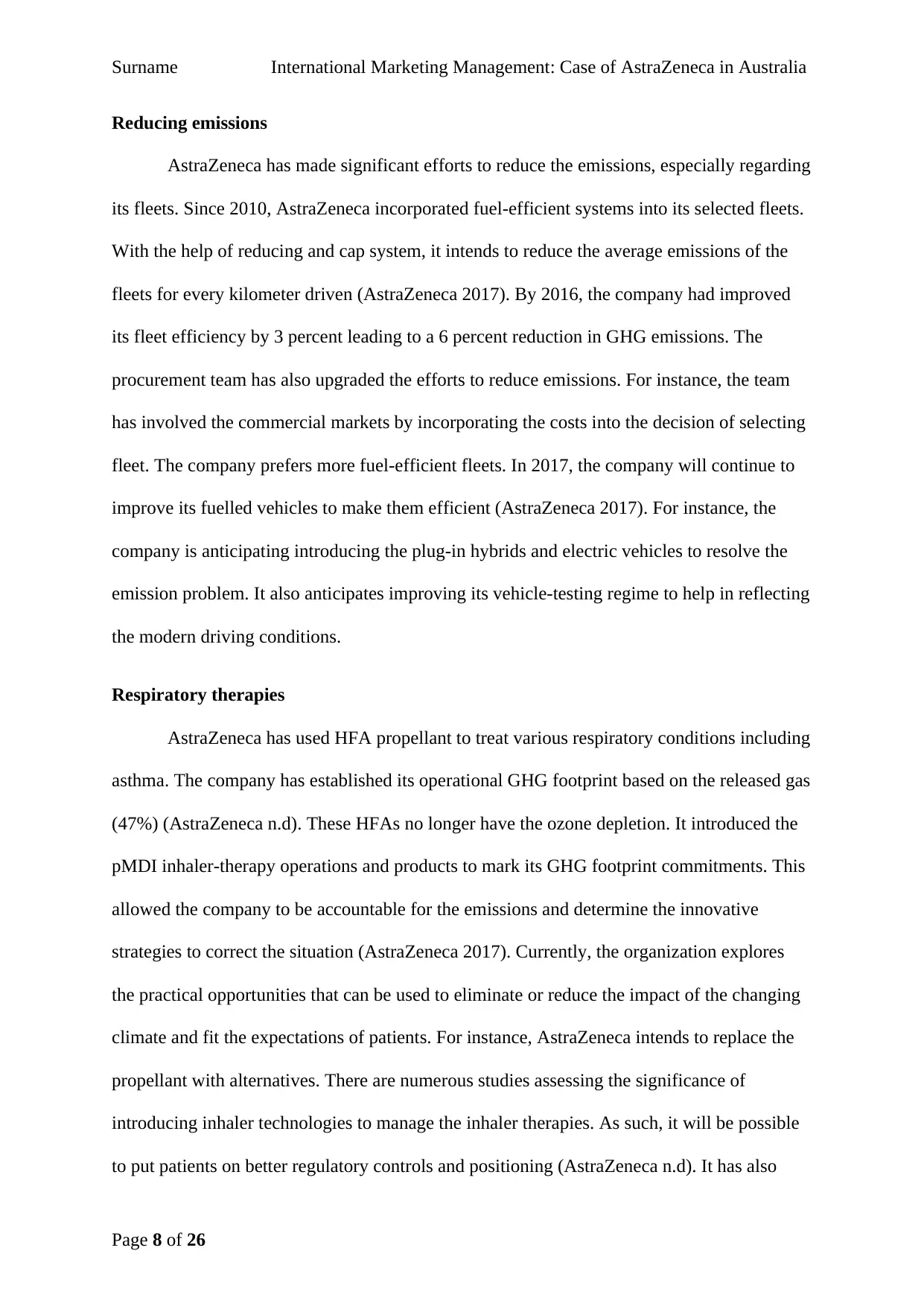
Surname International Marketing Management: Case of AstraZeneca in Australia
Reducing emissions
AstraZeneca has made significant efforts to reduce the emissions, especially regarding
its fleets. Since 2010, AstraZeneca incorporated fuel-efficient systems into its selected fleets.
With the help of reducing and cap system, it intends to reduce the average emissions of the
fleets for every kilometer driven (AstraZeneca 2017). By 2016, the company had improved
its fleet efficiency by 3 percent leading to a 6 percent reduction in GHG emissions. The
procurement team has also upgraded the efforts to reduce emissions. For instance, the team
has involved the commercial markets by incorporating the costs into the decision of selecting
fleet. The company prefers more fuel-efficient fleets. In 2017, the company will continue to
improve its fuelled vehicles to make them efficient (AstraZeneca 2017). For instance, the
company is anticipating introducing the plug-in hybrids and electric vehicles to resolve the
emission problem. It also anticipates improving its vehicle-testing regime to help in reflecting
the modern driving conditions.
Respiratory therapies
AstraZeneca has used HFA propellant to treat various respiratory conditions including
asthma. The company has established its operational GHG footprint based on the released gas
(47%) (AstraZeneca n.d). These HFAs no longer have the ozone depletion. It introduced the
pMDI inhaler-therapy operations and products to mark its GHG footprint commitments. This
allowed the company to be accountable for the emissions and determine the innovative
strategies to correct the situation (AstraZeneca 2017). Currently, the organization explores
the practical opportunities that can be used to eliminate or reduce the impact of the changing
climate and fit the expectations of patients. For instance, AstraZeneca intends to replace the
propellant with alternatives. There are numerous studies assessing the significance of
introducing inhaler technologies to manage the inhaler therapies. As such, it will be possible
to put patients on better regulatory controls and positioning (AstraZeneca n.d). It has also
Page 8 of 26
Reducing emissions
AstraZeneca has made significant efforts to reduce the emissions, especially regarding
its fleets. Since 2010, AstraZeneca incorporated fuel-efficient systems into its selected fleets.
With the help of reducing and cap system, it intends to reduce the average emissions of the
fleets for every kilometer driven (AstraZeneca 2017). By 2016, the company had improved
its fleet efficiency by 3 percent leading to a 6 percent reduction in GHG emissions. The
procurement team has also upgraded the efforts to reduce emissions. For instance, the team
has involved the commercial markets by incorporating the costs into the decision of selecting
fleet. The company prefers more fuel-efficient fleets. In 2017, the company will continue to
improve its fuelled vehicles to make them efficient (AstraZeneca 2017). For instance, the
company is anticipating introducing the plug-in hybrids and electric vehicles to resolve the
emission problem. It also anticipates improving its vehicle-testing regime to help in reflecting
the modern driving conditions.
Respiratory therapies
AstraZeneca has used HFA propellant to treat various respiratory conditions including
asthma. The company has established its operational GHG footprint based on the released gas
(47%) (AstraZeneca n.d). These HFAs no longer have the ozone depletion. It introduced the
pMDI inhaler-therapy operations and products to mark its GHG footprint commitments. This
allowed the company to be accountable for the emissions and determine the innovative
strategies to correct the situation (AstraZeneca 2017). Currently, the organization explores
the practical opportunities that can be used to eliminate or reduce the impact of the changing
climate and fit the expectations of patients. For instance, AstraZeneca intends to replace the
propellant with alternatives. There are numerous studies assessing the significance of
introducing inhaler technologies to manage the inhaler therapies. As such, it will be possible
to put patients on better regulatory controls and positioning (AstraZeneca n.d). It has also
Page 8 of 26
⊘ This is a preview!⊘
Do you want full access?
Subscribe today to unlock all pages.

Trusted by 1+ million students worldwide
1 out of 26
Related Documents
Your All-in-One AI-Powered Toolkit for Academic Success.
+13062052269
info@desklib.com
Available 24*7 on WhatsApp / Email
![[object Object]](/_next/static/media/star-bottom.7253800d.svg)
Unlock your academic potential
Copyright © 2020–2025 A2Z Services. All Rights Reserved. Developed and managed by ZUCOL.





